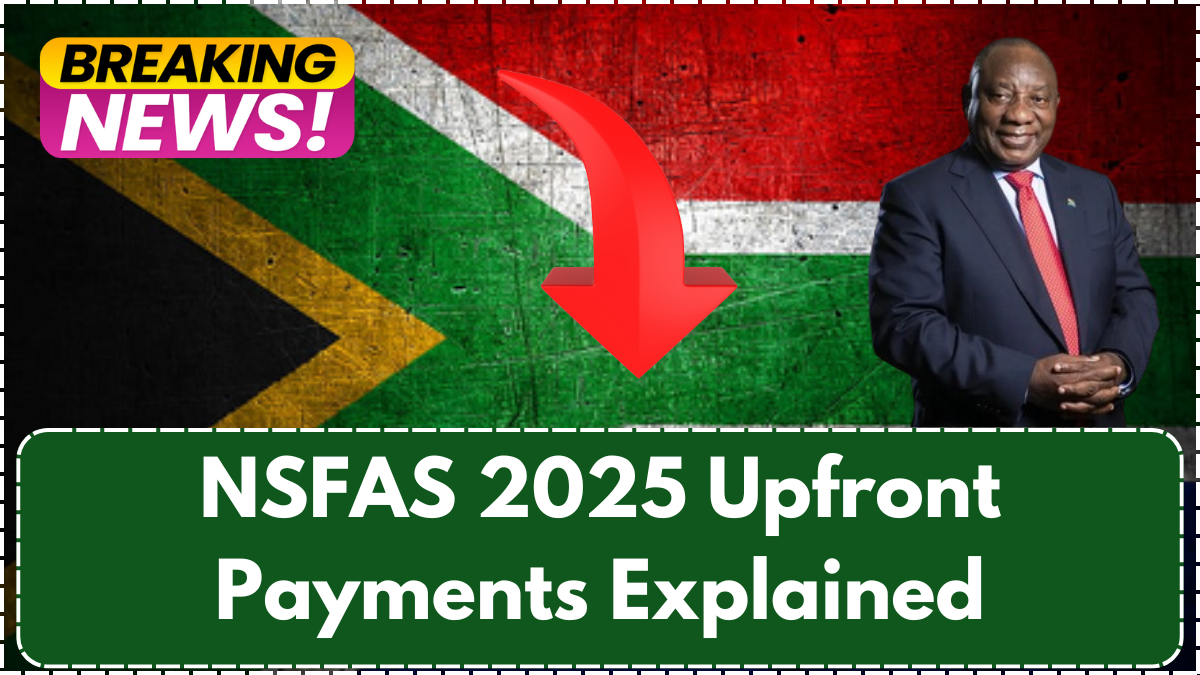As the 2025 academic year gets underway, South African universities and TVET colleges are actively preparing for a surge in student enrolments. Central to this effort is the National Student Financial Aid Scheme (NSFAS), which plays a pivotal role in delivering financial assistance to eligible students, covering their tuition, accommodation, transport, and living expenses. To support a smooth start, NSFAS has made strategic upfront payments to institutions to prevent delays during registration.

Why NSFAS Upfront Payments Matter in 2025
In previous years, payment delays caused serious registration bottlenecks at universities and colleges. Recognizing this recurring challenge, NSFAS released upfront disbursements on April 10, 2025, ensuring that institutions have the financial resources to support students from day one. This proactive move reinforces the government’s commitment to accessible and uninterrupted higher education.
Detailed Allocation of NSFAS Upfront Payments
Here’s how the NSFAS upfront funding for 2025 is structured:
| Category | Allocation Details |
|---|---|
| Student Allowances | One month of allowances for personal care, travel, meals, and essentials |
| Book Allowance | 50% of the total annual book allocation paid upfront |
| University Funding | 9.5% of the total R39 billion NSFAS budget for 2025 transferred to universities |
| College Tuition Payments | Direct funding allocated to TVET colleges to support tuition fees |
These disbursements enable institutions to register students without administrative or financial delays, fostering a smoother academic transition for both new and returning students.
University Admissions Crisis: Capacity vs. Demand
Despite a remarkable 2024 matric pass rate of 87.3%, South Africa’s higher education institutions are grappling with space shortages. A total of 337,158 students earned bachelor passes, yet only 202,000 first-year placements are available at universities.
Yearly Capacity Shortfall Snapshot
| Year | Bachelor Passes | University Capacity | Shortfall |
| 2024 | 337,158 | 202,000 | 135,158 |
| 2023 | 324,226 | 200,000 | 124,226 |
| 2022 | 312,000 | 198,000 | 114,000 |
This consistent gap highlights the urgent need for expanded infrastructure and diversified education pathways to accommodate growing academic demand.
How NSFAS Is Streamlining the Application Process
To improve efficiency and reduce uncertainty, NSFAS has upgraded its application review system for 2025. The new structure aims to provide quicker decisions before the academic year starts.
2025 NSFAS Application Status Overview
| Application Type | Status |
| SASSA Beneficiaries | 658,943 applications received, 606,113 provisionally approved |
| Non-SASSA Applicants | 276,072 under review, 201,848 verified |
| Student Loan Applications | 17,370 pending financial eligibility checks |
Applicants are urged to log into the NSFAS portal frequently to track progress and respond to any pending verifications.
TVET Colleges: A Viable and Valuable Alternative
To address the growing demand for post-school education, the Department of Higher Education and Training (DHET) is advocating for greater enrolment in Technical and Vocational Education and Training (TVET) colleges. These institutions offer practical, employment-oriented training that aligns with market needs.
Benefits of Enrolling in TVET Colleges:
- Job Readiness: Programs focus on equipping students with hands-on skills.
- Entrepreneurship: Courses support self-employment and small business creation.
- Industry Alignment: Curricula are tailored to meet current labor market demands.
- Infrastructure Growth: Ongoing government investment in facilities and equipment.
- Recognized Qualifications: All programs are accredited by the Quality Council for Trades and Occupations (QCTO).
TVET colleges are also expanding collaborations with industries, offering internships and practical placements that enhance job prospects.
Addressing Student Accommodation and Transportation Challenges
In a bid to improve student welfare, the Minister of Higher Education, Dr. Nobuhle Nkabane, has assembled a specialized task team. Their focus is on resolving the persistent issues of accommodation shortages and unreliable transport options.
Task Team Composition:
- NSFAS representatives
- University and college administrators
- Private and public accommodation providers
- Transport service stakeholders
The goal is to ensure that students have access to affordable, secure housing and reliable commuting options, helping them focus on their studies without logistical stress.
Conclusion
As South Africa enters the 2025 academic year, NSFAS continues to be a critical pillar in the education sector. Through timely upfront payments, streamlined application processes, and efforts to expand educational access via TVET institutions, NSFAS is paving the way for a more inclusive and efficient higher education system. While challenges around capacity and infrastructure remain, coordinated strategies between government departments and education stakeholders are fostering progress.
Frequently Asked Questions (FAQ)
Q1: When were NSFAS upfront payments made for 2025?
A1: The payments were made on April 10, 2025, ahead of the academic year.
Q2: How much of the book allowance was paid upfront?
A2: 50% of the annual book allowance was disbursed as part of the upfront payment.
Q3: How many students qualified for a bachelor’s program in 2024?
A3: A total of 337,158 students qualified for university degree programs.
Q4: What are the benefits of attending a TVET college?
A4: TVET colleges offer job-ready skills, practical training, and entrepreneurship opportunities, with programs aligned to industry needs.
Q5: How can students check their NSFAS application status?
A5: Students should regularly log into the NSFAS portal to monitor application updates and respond to any required actions.
Akesh is a furniture expert with years of experience in design and craftsmanship. Specializing in sustainable materials, he shares his expertise to help people create stylish and functional living spaces.
